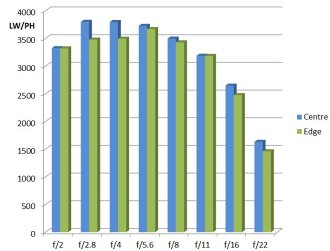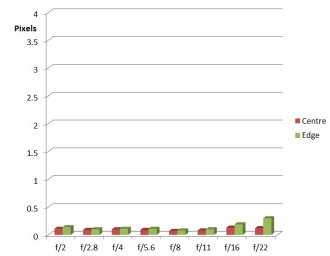Laowa 105mm f/2 STF Lens Review
Laowa 105mm f/2 T3.2 Smooth Trans Focus Performance
This lens is manual only in every respect, having no electronic communication with the camera, at least in Nikon mount. Focusing depends very much on the screen in the camera, and modern AF screens may not be the most suitable. Nonetheless, the moderate telephoto is sufficiently long to help the image snap in and out of focus.
Sharpness is very impressive throughout. Central sharpness starts off at an excellent level at f/2, approaching outstanding between f/2.8 and f/5.6, is excellent at f/8 and f/11, still very good at f/16 and only drops to fair at f/22. The smallest aperture is best avoided, as with many lenses, but is worth having there for situations where depth of field is the priority.
The edges are very close to the central sharpness figures, excellent all the way from f/2 through to f/11. Again, this drops to very good at f/16 and fair at f/22.
Sharpness tests using the T stops were also made. This makes no real difference to either CA or sharpness, and it all remains excellent throughout, centre and edge.
How to read our charts
The blue column represents readings from the centre of the picture frame at the various apertures and the green is from the edges.The scale on the left side is an indication of actual image resolution as LW/PH and is described in detail above. The taller the column, the better the lens performance.
For this review, the lens was tested on a Nikon D810 using Imatest.
The distortion level measures a very low -0.162% barrel. This is excellent, with virtually no bending of straight lines at all. CA (chromatic aberration) is also virtually zero, hovering around one tenth of a pixel, which is insignificant. Another excellent result.
How to read our charts
Chromatic aberration is the lens' inability to focus on the sensor or film all colours of visible light at the same point. Severe chromatic aberration gives a noticeable fringing or a halo effect around sharp edges within the picture. It can be cured in software.Apochromatic lenses have special lens elements (aspheric, extra-low dispersion etc) to minimize the problem, hence they usually cost more.
For this review, the lens was tested on a Nikon D810 using Imatest.
Flare was totally absent and cannot be seen in any of the shots taken. The coatings and hood are clearly efficient.
So, is the bokeh as sublime as suggested? Looking at the images I would say yes. The Apodization filter does seem to make a difference. There may also be a very slight difference between using the different diaphragm mechanisms. It's a subtle distinction, but the T stops might just have the edge. This may though also depend on subject matter.
Value For Money
Unique lenses can be difficult to place in context, but we do have two other lens options to compare with, albeit for specific marques.
In 1999 Minolta (later Sony) introduced the Smooth Trans Focus 135mm f/2.8 (T/4.5) lens at £939. In 2014 Fujifilm added the Fujinon XF 56mm f/1.2 R APD lens to their range, priced at £875.
Against this, the Laowa is priced at £549-649 depending on mount, which seems very reasonable.
Add your message
Please login here or if you've not registered, you can register here. Registering is safe, quick and free.
photodo Stats
428 MTF tests
74 in-depth photodo reviews
100+ users join each day
Help the lens community by reviewing or rating a lens today via our lens search
Latest Lens Reviews
- Chinon 28mm f/2.8 Vintage Lens Review
- Canon EF 70-200mm f/4L IS II USM Lens Review
- Samyang AF 85mm f/1.4 EF Review
- Sigma 70mm f/2.8 DG Macro Art Review
- Samyang AF 24mm f/2.8 FE Review
- Meike 50mm f/1.7 Review
- Tamron 70-210mm f/4 Di VC USD Review
- Lensbaby Burnside 35mm f/2.8 Review
- Asahi Super Takumar 50mm f/1.4 Review
- Asahi Super-Multi-Coated Takumar 135mm f/3.5 Review


